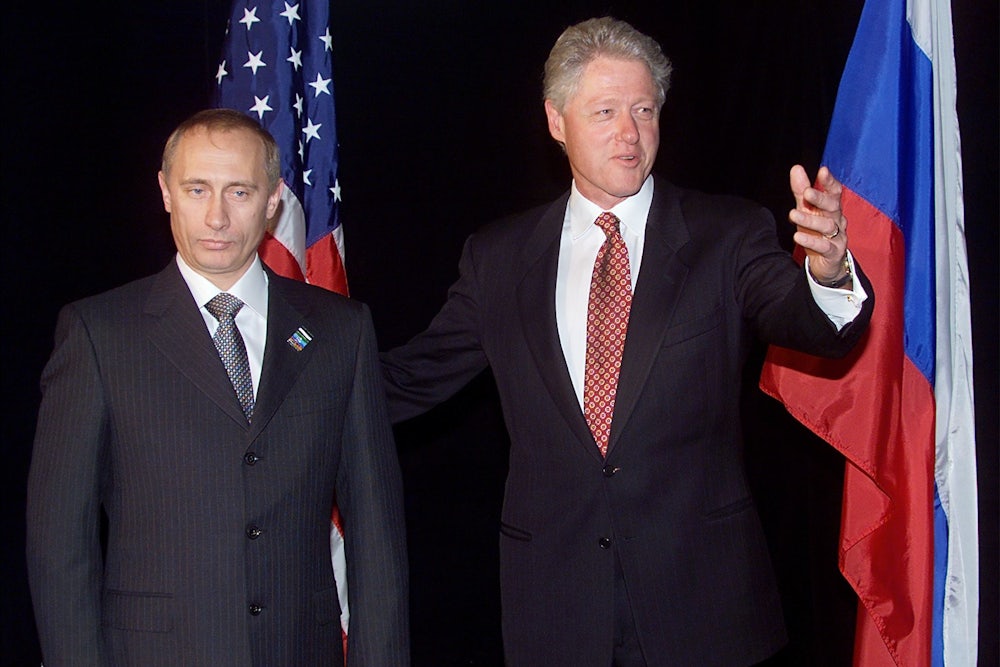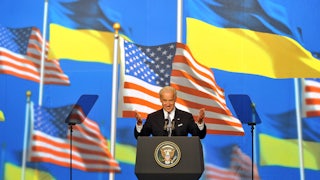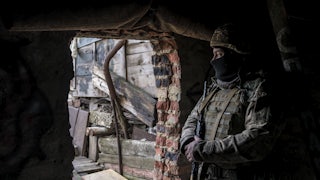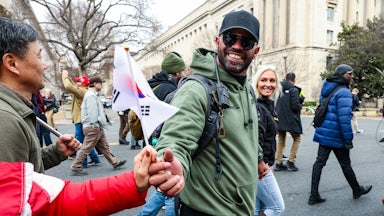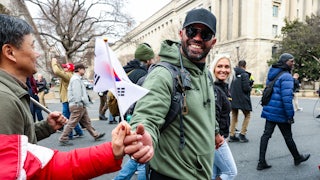In December 1988, the leader of the Soviet Union made a remarkable announcement at the United Nations. Mikhail Gorbachev declared the unilateral withdrawal of half a million Soviet troops from countries in Eastern Europe. “Further world progress is now possible only through the search for a consensus of all mankind, in movement toward a new world order,” he said.
Just over 33 years later, U.S. leaders are considering sending thousands of troops to some of the same lands from which Soviet troops retreated. Gorbachev himself has celebrated Russia’s recent annexation of some of its former empire. Far from any consensus on a new world order, relations between Russia and America and its allies have deteriorated to a degree that would have astonished and depressed those who witnessed the Soviet Union’s extraordinary, voluntary, relatively peaceful self-destruction. The descent from the optimistic, friendly era that surrounded the end of the Cold War to today’s hostility has been usually attributed to Russian leader Vladimir Putin’s malevolence or NATO’s progressive expansion into Eastern Europe. Truth exists in both of these explanations, but they leave much out.
The last phase of the Cold War was shockingly swift and took all policymakers involved by surprise. In late summer 1989, the borders between Austria and Hungary became porous, weakening the Iron Curtain. The Berlin Wall was torn down two months later. In 1990, Germany was reunified, integrating into NATO. The next year, the Soviet Union formally dissolved. Over the next decade and into the twenty-first century, NATO expanded east repeatedly.
Certainly, NATO’s enlargement beyond what used to be called West Germany has provoked Russia. But the ways in which NATO enlarged were as impactful as its fact. Not One Inch, the timely new book by the Johns Hopkins historian M.E. Sarotte, uses untapped archives and declassified documents (including some remarkable transcripts) to prove definitively that American, German, and Soviet leaders explicitly spoke about the possibility of NATO enlargement in the late 1980s and 1990s. These records disprove claims by Clinton administration officials and others (including Gorbachev himself) that the topic wasn’t discussed, or discussed only in reference to a reunified Germany. “I personally do not have a problem with NATO expansion—the problem was how it happened,” Sarotte says. It was done in a way that “would maximize frictions with Russia,” she says.
It’s worth noting that the final treaty approving German reunification, agreed to in 1990, applied only to Europe, which American policymakers have pointed to as evidence that the United States never made any promises about further NATO expansion. Instead, the Unification Treaty allowed the new Federal Republic of Germany to retain West Germany’s status as a member of NATO, the United Nations, and the European Economic Community (the precursor to the European Union).
But as the political scientist Joshua Shifrinson has pointed out, this legalistic interpretation of America’s assurances—to say nothing of West German leaders’ more explicit language—obscures the more general point that the U.S. repeatedly told Soviet leaders that it would incorporate Russia into a cooperative European security framework. All the while, we actually constructed an American-dominated system. Nearly 75,000 American troops remain in Europe, U.S. nuclear weapons are stationed in multiple European countries, and NATO has mushroomed to 30 members. “The current crisis has many sources,” says Shifrinson, but “you can understand why, if you’re sitting in Moscow, you might not have total faith in the U.S. as a negotiating partner; and why today we see Russian leaders demanding written assurances and treaties on these matters, all of which make diplomacy much more difficult.”
There were alternatives to this system. Soviet leaders, in 1989 and 1990, suggested disbanding both NATO and the Warsaw Pact and creating a joint Conference on Security and Cooperation in Europe. French leaders supported something similar, and American leaders agreed but consistently downplayed it in favor of NATO. The subsequent rounds of NATO expansion must be seen as efforts not just to extend a military alliance close to Russian borders but as violations of vows not to exploit Soviet weakness. “From the very beginning, the Russians said, ‘Don’t do this, we don’t like this, this makes us uncomfortable,’” says Georgetown University’s Charles Kupchan, who worked on European affairs in the Clinton administration’s National Security Council. “At the end of the day, those concerns were not enough to stop the process.”
NATO expanded apace. Poland, the Czech Republic, and Hungary joined in 1999; Romania, Bulgaria, and the Baltic states in 2004. However, the multiple instances of NATO expansion were far from the only policies to exploit Russian feebleness. Nuclear arms control policies are another. Although a major focus of U.S. efforts during the Cold War’s closing phase, reductions in nuclear forces lost momentum in the 1990s. They weren’t a priority for the Clinton administration, which failed to finish the Start II Treaty or ratify the Comprehensive Nuclear Test-Ban Treaty.
But George W. Bush’s administration turned apathy about arms control into opposition. In December 2001, Bush announced that the U.S. was unilaterally withdrawing from the Anti-Ballistic Missile Treaty, in effect since 1972. The Bush administration declined to negotiate over nuclear arms at all. Now led by Putin, Russia opposed the move. Again, the method was madness: Bush’s snub, unimaginable during the Cold War, came right after Putin had offered U.S. significant help following the 9/11 terrorist attacks.
The wars in Bosnia and especially Kosovo were exceptionally provocative to Russia. The 1999 conflict in Kosovo was the background for a round of NATO expansion, which U.S. leaders had consistently said would lead to a more peaceful Europe. Instead, as NATO was letting new members participate and formalizing a process to invite further members, the organization was bombing Yugoslavia, without even a Security Council Resolution. “It is hard to overstate how profound an effect that had in Moscow,” says Sarotte. “We did not appreciate it in the West and still do not to this day.”
Part of what makes the decline of the U.S.-Russian relationship tragic is that America sometimes had good reasons for ignoring or overlooking Russian sensibilities. As Kupchan says, “From the Kremlin’s perspective, Russia has been the object of decisions about Europe’s security order rather than a participant—and that’s to some extent their own fault because they have behaved in ways that make them the object of NATO and U.S.-European cooperation.”
During the Balkan Wars of the 1990s, Russia consistently—and correctly—charged NATO states with violating the principles of sovereignty and equality between states that underpin the United Nations. Less rightly, Russian leader Boris Yeltsin even said that NATO risked launching a world war with its actions. But sovereignty is not the only virtue in foreign affairs, as Russia’s interference in the conduct of other countries well attests. By intervening in the Balkans, the U.S. helped stop the ethnic cleansing underway and forced Serbian leader Slobodan Milošević to withdraw the troops he controlled who were bent on genocide. Similarly, NATO expansion “did play a role in stabilizing Eastern Europe, and continues to embody the liberal principles of integration,” as the scholars Daniel Deudney and G. John Ikenberry put it in a judicious essay, “The Unravelling of the Cold War Settlement.”
The problem is that Russian interests and sensibilities were disregarded in the process, something American policymakers deluded themselves into thinking would have few consequences. That proved true over and again, even when the U.S. was funding democratic movements in Russia itself—that is, when supporting actors who threatened Putin’s regime. “The problem today is that you have a European security system in which Russia has no stake and no place,” says Sarotte. Russia is the biggest country in Europe in terms of both landmass and military capabilities. Any system excluding it is unsustainable.
As Shifrinson notes, part of the current malaise is structural: It was probably inevitable that the U.S. and Russia would return to a frosty relationship rather than perceptually extend the harmony that began during the Gorbachev era. “States, as they grow in power, tend to want more influence in the world,” he says. “Russian power has recovered relative to where it was in 1991, 1992, 1993, and 1994.” As that happened, Russia’s leaders were likely to act aggressively in some ways, especially regarding Ukraine or other countries on its border. But by ignoring their vital interests over and over, we made their aggression worse (bloodier) and more widespread (especially in interfering in Western countries) than it probably would have been.
Given that Russia is again a powerful country to be reckoned with, concurrent with China’s rise, it might make sense to strengthen the G-20 or revive a Concert of Powers, something suggested by Council on Foreign Relations head Richard Haass and Kupchan last year. Says Kupchan: “Would it help to create a forum for greater dialog with Russia? Yes. Are we going to get there? A lot depends on what happens in the coming weeks. I think if Russia invades Ukraine, we’re going to be back in something that looks not dissimilar from the Cold War.”
If that happens, Russia could expand on its campaigns of spreading misinformation and chaos in Western countries. The U.S. and its allies can show diplomatic flexibility by declaring that Ukraine will remain neutral and not join NATO, at least for a decade. Ultimately, a neutral Ukraine is the only long-term solution to what has unnecessarily become the biggest threat to European security since the glorious days of 1989 and 1990.
